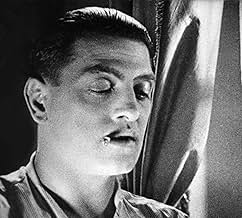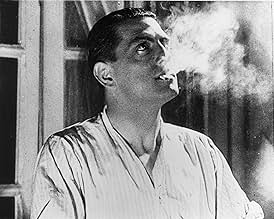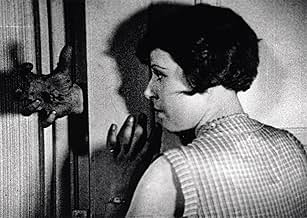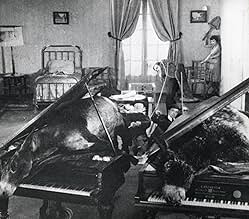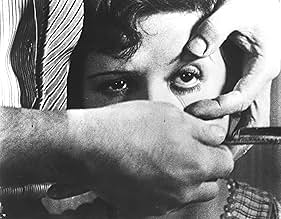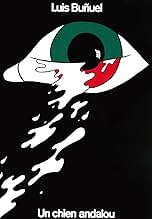PUNTUACIÓN EN IMDb
7,6/10
55 mil
TU PUNTUACIÓN
Luis Buñuel y Salvador Dalí presentan 16 minutos de imágenes extrañas y surrealistas.Luis Buñuel y Salvador Dalí presentan 16 minutos de imágenes extrañas y surrealistas.Luis Buñuel y Salvador Dalí presentan 16 minutos de imágenes extrañas y surrealistas.
Pierre Batcheff
- Man
- (as Pierre Batchef)
Simone Mareuil
- Young Girl
- (as Simonne Mareuil)
Luis Buñuel
- Man in Prologue
- (sin acreditar)
Pancho Cossío
- Stroller
- (sin acreditar)
Salvador Dalí
- Seminarist
- (sin acreditar)
Juan Esplandiu
- Stroller
- (sin acreditar)
Robert Hommet
- Young Man
- (sin acreditar)
Marval
- Seminarist
- (sin acreditar)
Fano Messan
- Hermaphrodite
- (sin acreditar)
Jaume Miravitlles
- Fat Seminarist
- (sin acreditar)
Argumento
¿Sabías que...?
- CuriosidadesAt the Paris premiere, Luis Buñuel hid behind the screen with stones in his pockets for fear of being attacked by the confused audience. Nothing of the sort happened. In fact, the audience loved its mysterious and incomprehensible plot.
- Versiones alternativasThe film was re-released in 1960 with soundtracks.
- ConexionesEdited into Avant-garde Cinema (1960)
Reseña destacada
I still remember my visit to Philadelphia Museum of Art, back in the April of 2005. One of the reasons I went there was to to see the Salvador Dali's exhibitions but the tickets were sold out. While in the museum, I was able to see two films that Dali was a big part of. In the video Gallery of the museum, two intriguing projects have been running together in the continuous loop, the early "Un Chien Andalou" (17 minutes) and the recently released, animated Destino (6 minutes). This was the first viewing for me. I kept coming back to the gallery few more times and I never was tired of both short films.
The inspiration for "Un Chien Andalou" began with the dreams of two young rebellious men, the artists and the friends, Luis Bunuel and Salvador Dali. They exchanged the dreams they both had, Bunuel - about a slender cloud slicing the moon in half "like a razor blade slicing through an eye", and Dali - about a dream involving a hand enveloped by ants. Both artists soon began working on a film script based on these ideas.
Made in 1929, the film has not aged at all. Its disconnected but haunting scenes and images are as shocking today (at least, for me they were) as I am sure they were all these years ago for the viewers who faced them for the first time. The reason the film is so powerful even now may be the themes of love, sex, death, and decay that are eternal and will always attract the artists and audiences alike. It is also could be in the establishing and following by both artists the certain rules, "No idea or image that might lend itself to a rational explanation of any kind will be accepted...We had to open all doors to the irrational and keep only those images that surprised us without trying to explain why." Perhaps, Dali and Bunuel intended their film to be experienced directly, on the visceral level, and not analyzed by the viewers.
The inspiration for "Un Chien Andalou" began with the dreams of two young rebellious men, the artists and the friends, Luis Bunuel and Salvador Dali. They exchanged the dreams they both had, Bunuel - about a slender cloud slicing the moon in half "like a razor blade slicing through an eye", and Dali - about a dream involving a hand enveloped by ants. Both artists soon began working on a film script based on these ideas.
Made in 1929, the film has not aged at all. Its disconnected but haunting scenes and images are as shocking today (at least, for me they were) as I am sure they were all these years ago for the viewers who faced them for the first time. The reason the film is so powerful even now may be the themes of love, sex, death, and decay that are eternal and will always attract the artists and audiences alike. It is also could be in the establishing and following by both artists the certain rules, "No idea or image that might lend itself to a rational explanation of any kind will be accepted...We had to open all doors to the irrational and keep only those images that surprised us without trying to explain why." Perhaps, Dali and Bunuel intended their film to be experienced directly, on the visceral level, and not analyzed by the viewers.
- Galina_movie_fan
- 4 may 2005
- Enlace permanente
Selecciones populares
Inicia sesión para calificar y añadir a tu lista para recibir recomendaciones personalizadas
Detalles
- Duración16 minutos
- Color
- Mezcla de sonido
- Relación de aspecto
- 1.33 : 1
Contribuir a esta página
Sugerir un cambio o añadir el contenido que falta

Principal laguna de datos
By what name was Un perro andaluz (1929) officially released in India in English?
Responde

